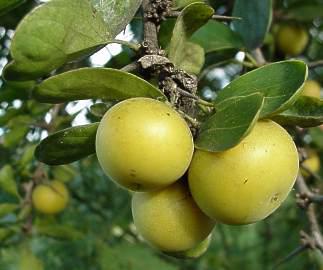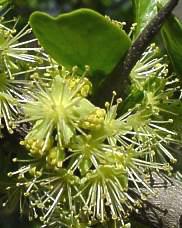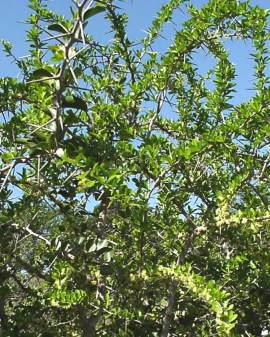Dovyalis caffra
Dovyalis caffra (Hook.f. & Harv.) Hook.f.
Family: Salicaceae
Common names: Kei-apple (Eng.); Kei-appel (Afr.); motlhono (North Sotho); umqokolo (Zulu); amaqokolo (Ndebele); mukokolo (Shona)
SA Tree No: 507
Introduction
Dovyalis caffra is a lovely evergreen fruit tree or shrub. It is one of the three Dovyalis species, together with D. zeyheri (wild apricot) and D. rhamnoides (common sour berry), which are of considerable importance as a source of income for some local communities in southern Africa. A trial planting of southern African fruit trees in a desert in Israel is also going to include this plant (Dovyalis caffra). It is an attractive, drought- and frost-resistant tree or shrub.

Description
Description
Dovyalis caffra is usually 3-5 m in height, but sometimes reaches 8 m with a much branched crown. It is a tree or spiny shrub of moderate growth rate that may be planted close together to form a good hedge. Creamy green flowers form in November to December. Male flowers are 3 mm long in dense clusters of 5-10 flowers. Female flowers are found in groups of up to three on stalks 4-10 mm long in leaf axils. The fruits are up to 60 mm in diameter and are yellowish-orange in colour.

Distribution and habitat
Distribution description
The Kei-apple grows in valley bushveld, dry areas, wooded grassland, on forest edges, from Eastern Cape through KwaZulu-Natal to Swaziland, into Limpopo [Northern Province] and Zimbabwe.
Derivation of name and historical aspects
History
Dovyalis is a Greek word meaning spear, and caffra is derived from Kaffraria (Eastern Cape).
Ecology
Ecology
Insects and birds play a very important role in pollinating this tree. Birds such as the louries and the black-eyed bulbuls love the fruits of a Dovyalis caffra, which are delicious. By eating the fruits, birds also help to distribute the seeds. Baboons, antelope and monkeys also like to eat the fruit.
Uses
Use
Dovyalis caffra can be cultivated as a border or a screen, or used to form an impenetrable hedge around a garden to keep unwanted animals and people out. It will grow well in either full sun or light shade, and will also need regular trimming in order to maintain a good hedge. The leaves are used as fodder (bulk feed for livestock). The fruits are edible, and make excellent jam.

Growing Dovyalis caffra
Grow
The Kei-apple is easily propagated from seed. The fruits must be ripe before they are collected. The seed must be cleaned and dried in a shady spot before planting. They should then be sown in seedling trays filled with river sand or seedling mix. The seeds must be pressed down into the sand until they are level with the surface of the sand and then covered with a layer of fine sand. The Kei-apple can also be propagated from hardwood cuttings as long as they are treated with root-stimulating hormone before planting. It also has a good growth rate of about 600 mm per year.
References
- Germishuizen, G., Meyer, N.L., Steenkamp, Y. & Keith, M. (eds) 2006. A Checklist of South African plants. Southern African Botanical Diversity Network Report No. 41. SABONET, Pretoria.
- COATES PALGRAVE, K. 1981. Trees of South Africa, edn 2. Struik, Cape Town.
- DHARANI, N. 2002. Field guide to common trees and shrubs of East Africa. Struik, Cape Town.
- JOFFE, P. 1993. The gardener's guide to South African plants. Tafelberg, Cape Town.
- VAN WYK, B. & GERICKE, N. 2000. People's plants. A guide to useful plants of South Africa. Briza Publications, Pretoria.
Credits
Phillemon Ndou
Witwatersrand National Botanical Gardens
April 2003
Plant Attributes:
Plant Type: Shrub, Tree
SA Distribution: Eastern Cape, KwaZulu-Natal, Limpopo, Mpumalanga, Western Cape
Soil type: Sandy
Flowering season: Late Summer
PH:
Flower colour: Cream
Aspect: Full Sun, Morning Sun (Semi Shade)
Gardening skill: Easy
Special Features:
Horticultural zones










Rate this article
Article well written and informative
Rate this plant
Is this an interesting plant?
User Comments
Ray Cox, South Africa
March 03, 2018 at 8:23 PMWhere can I get seeds from?
Alice Notten
March 06, 2018 at 10:47 AMHello Ray
Try the Kirstenbosch Seedroom: seedroom@sanbi.org.za
Or download the seed catalogue from this page: http://www.sanbi.org/gardens/kirstenbosch/kirstenbosch-nbg-seedroom
Login to add your Comment
Back to topNot registered yet? Click here to register.